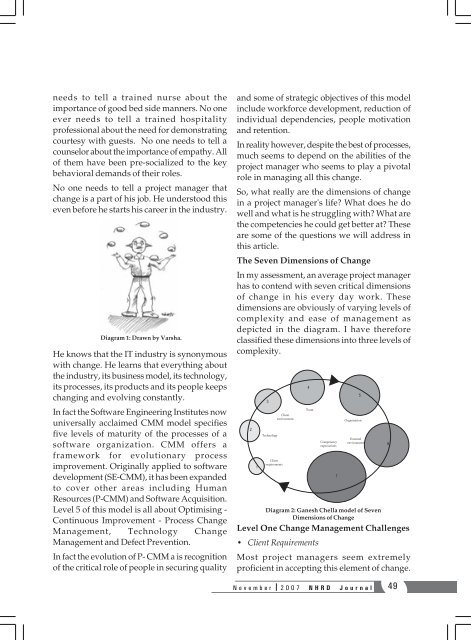NHRD Journal - National HRD Network
NHRD Journal - National HRD Network
NHRD Journal - National HRD Network
Create successful ePaper yourself
Turn your PDF publications into a flip-book with our unique Google optimized e-Paper software.
needs to tell a trained nurse about the<br />
importance of good bed side manners. No one<br />
ever needs to tell a trained hospitality<br />
professional about the need for demonstrating<br />
courtesy with guests. No one needs to tell a<br />
counselor about the importance of empathy. All<br />
of them have been pre-socialized to the key<br />
behavioral demands of their roles.<br />
No one needs to tell a project manager that<br />
change is a part of his job. He understood this<br />
even before he starts his career in the industry.<br />
Diagram 1: Drawn by Varsha.<br />
He knows that the IT industry is synonymous<br />
with change. He learns that everything about<br />
the industry, its business model, its technology,<br />
its processes, its products and its people keeps<br />
changing and evolving constantly.<br />
In fact the Software Engineering Institutes now<br />
universally acclaimed CMM model specifies<br />
five levels of maturity of the processes of a<br />
software organization. CMM offers a<br />
framework for evolutionary process<br />
improvement. Originally applied to software<br />
development (SE-CMM), it has been expanded<br />
to cover other areas including Human<br />
Resources (P-CMM) and Software Acquisition.<br />
Level 5 of this model is all about Optimising -<br />
Continuous Improvement - Process Change<br />
Management, Technology Change<br />
Management and Defect Prevention.<br />
In fact the evolution of P- CMM a is recognition<br />
of the critical role of people in securing quality<br />
and some of strategic objectives of this model<br />
include workforce development, reduction of<br />
individual dependencies, people motivation<br />
and retention.<br />
In reality however, despite the best of processes,<br />
much seems to depend on the abilities of the<br />
project manager who seems to play a pivotal<br />
role in managing all this change.<br />
So, what really are the dimensions of change<br />
in a project manager's life? What does he do<br />
well and what is he struggling with? What are<br />
the competencies he could get better at? These<br />
are some of the questions we will address in<br />
this article.<br />
The Seven Dimensions of Change<br />
In my assessment, an average project manager<br />
has to contend with seven critical dimensions<br />
of change in his every day work. These<br />
dimensions are obviously of varying levels of<br />
complexity and ease of management as<br />
depicted in the diagram. I have therefore<br />
classified these dimensions into three levels of<br />
complexity.<br />
Diagram 2: Ganesh Chella model of Seven<br />
Dimensions of Change<br />
Level One Change Management Challenges<br />
• Client Requirements<br />
Most project managers seem extremely<br />
proficient in accepting this element of change.<br />
November 2007 <strong>N<strong>HRD</strong></strong> <strong>Journal</strong> 49
















